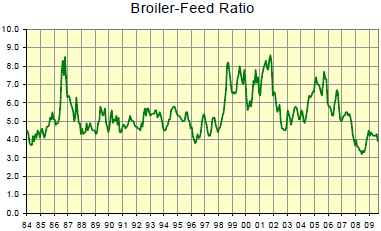



CME: Broiler-Corn Ratio Heading Downhill
US - "First, a small errata: Chicken production for one year ago in Friday’s Production and Price Summary table should have been 926.17 million pounds, leaving last week’s output down 0.7 per cent from one year ago," write Steve Meyer and Len Steiner.We incorrectly pulled total chicken instead of young chicken output for last year. The difference between those numbers is production from culled hens.
Lest anyone think that the recent decline in grain prices and increase in hog, cattle and chicken prices have returned producers of the three major species to profits, consider the updated charts of outputto- feed price ratios at right. These data are published monthly by USDA’s National Agricultural Statistics Service in Agricultural Prices, published near the end of each month. The Daily Livestock Report website contains a link to Agricultural Prices.
All of these output-to-feed ratios remain near their historic lows. August’s hog-corn ratio was 12.0, the same as in July and slightly higher than last August’s 11.5. That figure occurred even though hog prices were at record high levels because, of course, corn prices were also at record-high levels. The previous record lows were set in the fall of 1998 when hog prices plummeted.

The cattle-corn ratio has improved more than has the ratio for hogs but still remains poor by historical standards. The August ratio was 25.6, up nearly 2 from July and significantly higher than the 19.0 of August 2008. It is interesting to note that the only time that the cattle-corn ratio has been lower than last summer was in the summer of 1996 when corn prices last set record highs.

The broiler-feed ratio has actually declined since last December when it reached 4.5. August’s figure of 3.9 is significantly better than the 3.3 of last year. Continuing difficulties in the breast meat market and sharply lower leg quarter prices this summer have pressured composite broiler prices enough to offset lower corn costs. Readers should note that USDA uses a feed index comprised of 58 pounds of corn and 42 pounds of soybean meal for broilers. This summer’s higher soybean meal prices have been a major factor in lower broilerfeed ratios.

The bottom line is that all three of these sectors are still getting strong liquidation signals. The hog ratio needs to be 15 or better just to have stability; 20 or more for growth. The critical value for cattle is 30:1 while it appears that the chicken:feed ratio needs to get back near 5:1 before the sector will show significantly higher financial performance. All are still a long way from stability.








